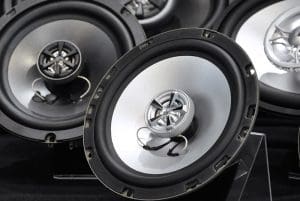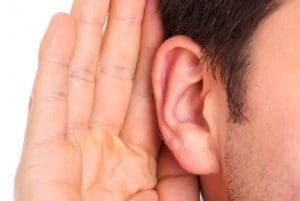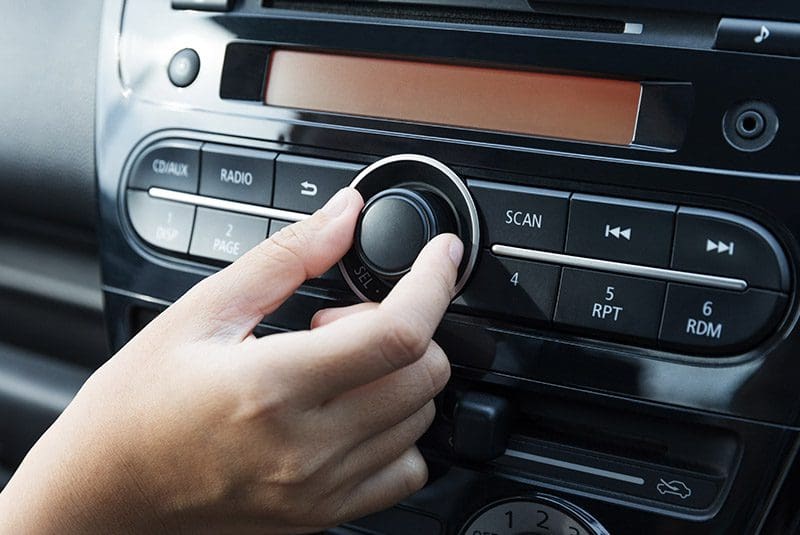Whether the sound system in your car or truck is bone stock or upgraded with premium amplifiers, speakers and subwoofers, the system’s maximum volume may not directly coincide with turning the knob up all the way. The short and sweet of why this happens is something called gain overlap. This conscious and deliberate design decision ensures that any signal source can be played at the maximum volume level as determined by the system’s amplifiers. Are you confused? Fear not! As always, we’ll explain.
What Determines How Loudly a Car Stereo Can Play?
 In most cases, the maximum output capability of your car stereo is determined by the power available from the amplifiers to drive the speakers. When you run out of power, the signal produced by the amp distorts heavily, and the sound becomes garbled and unpleasant.
In most cases, the maximum output capability of your car stereo is determined by the power available from the amplifiers to drive the speakers. When you run out of power, the signal produced by the amp distorts heavily, and the sound becomes garbled and unpleasant.
In some systems, the limiting factor may be the quality or configuration of the speakers used in the vehicle. If the speakers aren’t operating in their optimal range, you may hear a snapping sound as the voice coil former smashes into the back plate. This is a rare occurrence but it does happen.
Audio System Gain Structure
 When you have an amplifier connected to a radio, most people think that the installer (or system designer, in the case of a factory-installed sound system) should configure the amplifier so that it makes full power when you crank the volume to its highest setting. This simple 1:1 ratio works great for music that is recorded loudly.
When you have an amplifier connected to a radio, most people think that the installer (or system designer, in the case of a factory-installed sound system) should configure the amplifier so that it makes full power when you crank the volume to its highest setting. This simple 1:1 ratio works great for music that is recorded loudly.
There is a significant drawback to this configuration. What happens when you have an audio source that is quiet? A good example of this is the release of the Dire Straits’ 2005 album, Brothers in Arms. This (admittedly amazing) album is recorded with a wide dynamic range and a relatively low average volume level. Scientifically speaking, the track “Money for Nothing” has an average amplitude of -22 dBFS (decibels referenced to the maximum recording level), even if the peaks are recorded at the maximum allowable level on the CD. By comparison, the Daft Punk track “Give Life Back to Music” has an average level of -17dBFS. You need about five dB more gain in your system to make Mark Knopfler and Company appear to be performing at the same average volume level.
What Happens When Full Volume Isn’t Enough?
 Audio system designers include something called gain overlap in the system to allow these quiet musical passages to be played at the same level as tracks that are recorded loudly. The drawback of this (very common) feature is that your system will distort heavily if you play loudly recorded music at full volume.
Audio system designers include something called gain overlap in the system to allow these quiet musical passages to be played at the same level as tracks that are recorded loudly. The drawback of this (very common) feature is that your system will distort heavily if you play loudly recorded music at full volume.
In these situations, the person operating the sound system (you) needs to know when you have maxed out the capabilities of your amplifier and stop turning the volume up. Many mobile electronics specialist retailers will tell you that a volume setting of 27 out of 30 may be as high as you can turn up the system. This limit is determined using test tones recorded at high volume levels. Following this guideline ensures that your system will never distort. With that said, if you have selected a source that isn’t as loud, whether it’s Bluetooth, files on a USB stick, a quiet compact disc or the 1/8-inch auxiliary input, having a few notches left over to turn the volume up a little higher is very welcome.
What Happens When You Exceed Maximum Volume?
 As we mentioned at the beginning of this article, in most cases, audio systems are limited by the power available from the system amplifiers. When you reach this limit, the amp will “clip.” Clipping adds large quantities of harmonic distortion to the output signal and dramatically increases the energy delivered to high-frequency speakers. This extra energy can cause mids and tweeters to fail prematurely.
As we mentioned at the beginning of this article, in most cases, audio systems are limited by the power available from the system amplifiers. When you reach this limit, the amp will “clip.” Clipping adds large quantities of harmonic distortion to the output signal and dramatically increases the energy delivered to high-frequency speakers. This extra energy can cause mids and tweeters to fail prematurely.
If your upgraded audio system is configured to include some amount of gain overlap, work with the person who tuned the system to understand its limits. You are getting all the performance possible from your audio system, even if the volume on the radio isn’t at full. Your local mobile enhancement retailer can provide specifics about the limits of your factory source unit and explain how they can improve the detail, accuracy and emotional impact of your car stereo system.

